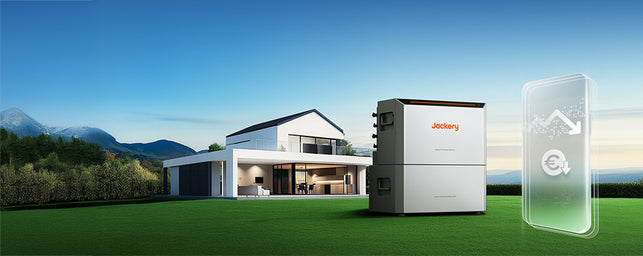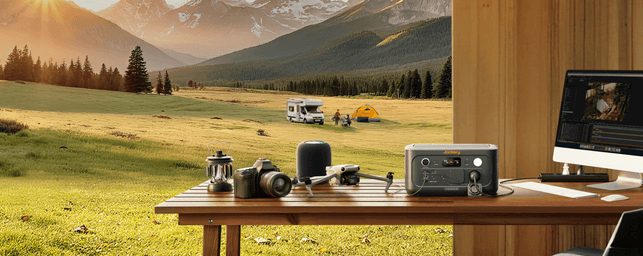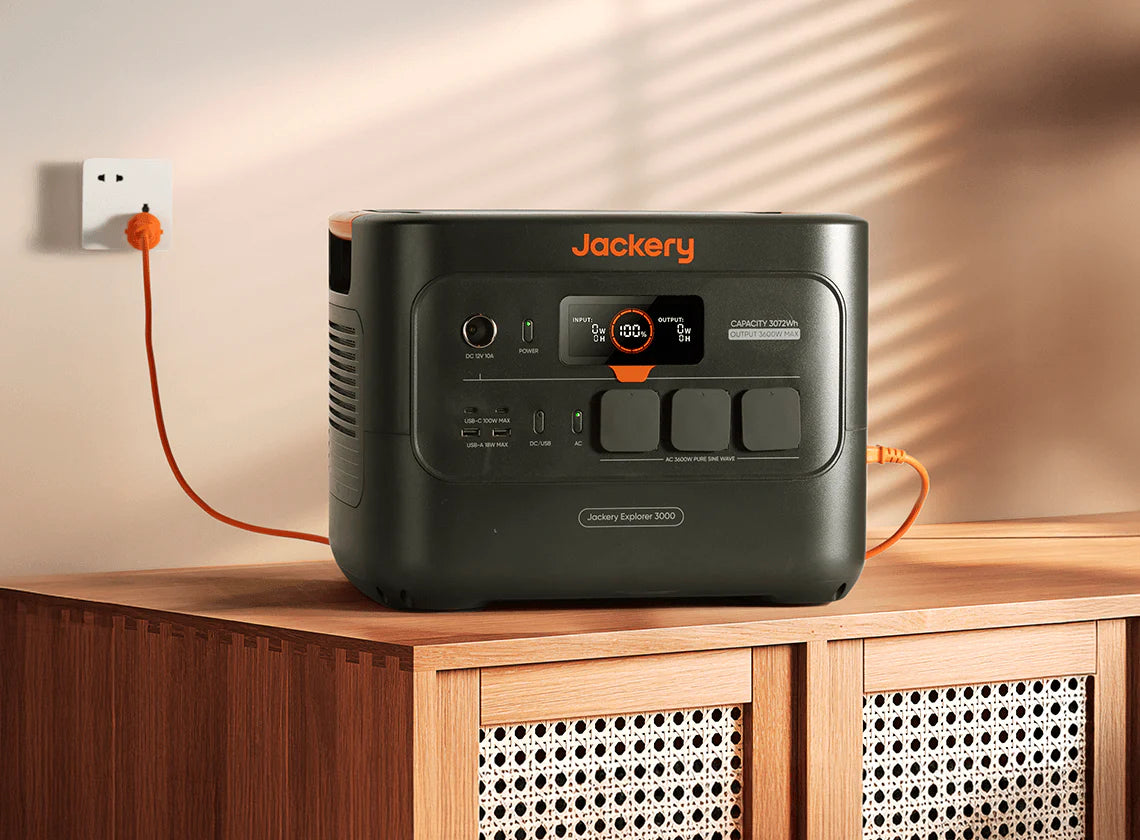Houseboats are now recognised as a practical choice for modern living. In many cities, they function as permanent homes, holiday rentals, or leisure spaces on the water. Families view them as an alternative to crowded housing, while travellers enjoy them as unique places to stay. Their popularity also reflects a stronger focus on sustainable lifestyles and creative use of limited space.
But life on a houseboat is not that easy. The main concern is reliable access to electricity to operate appliances on board. Solar power stations, power generators are effective solutions. Water is also a big problem. How to set up a good layout for peaceful, worry-free days floating on water? This guide will help you resolve these problems from start to finish.
What Do You Know About Houseboat Types?
Houseboats come in many forms, and understanding their differences will help you choose the best option for your needs. Here are the different types of houseboats available:
Classification by Purpose
Houseboats can be divided by the purpose they serve.
- Recreational houseboats are built for short stays on the water. They usually offer simple facilities such as a small kitchen, compact sleeping area, and basic bathroom, making them suitable for holidays or weekend trips.
- Permanent residence houseboats are more advanced, designed with proper insulation, reliable utilities, and layouts that support year-round living. Families often choose them as an alternative to traditional housing.
- Rental houseboats are a growing option as they combine comfort with practicality. These are typically equipped with stylish interiors and reliable safety systems to attract short-term visitors. In many tourist regions, rental houseboats are an important source of local income and a way to promote cultural experiences.
Classification by Design and Size
Houseboats can also be divided by their sizes and designs.
Narrowboats
- Widely used in the canals of the United Kingdom
- Slim and elongated shape for easy movement through narrow waterways
Barges
- Common in France and the Netherlands
- Wider vessels with more living space
- Often includes multiple rooms
Modern floating homes
- Looks similar to small apartments
- Offer open kitchens, separate bedrooms, and even outdoor decks
Smaller houseboats
- Easier to handle and relocate
Larger houseboats
- Provide more comfort
- Typically kept in one place
Owners often select the design not only for space but also for compliance with local canal or river regulations.
|
Category |
Type / Object |
Key Features |
|
Houseboats – by Purpose |
Recreational houseboats |
Built for short stays; simple facilities (small kitchen, compact bedroom, basic bathroom); ideal for holidays or weekend trips |
|
Permanent residence houseboats |
Designed with insulation, reliable utilities, and year-round layouts; often chosen by families as an alternative to traditional housing |
|
|
Rental houseboats |
Blend comfort with practicality; stylish interiors and safety systems; popular in tourist regions, generating local income and offering cultural experiences |
|
|
Houseboats – by Size & Design |
Narrowboats |
Common in UK canals; slim and elongated to navigate narrow waterways |
|
Barges |
Found in France and the Netherlands; wider vessels with more space and multiple rooms |
|
|
Modern floating homes |
Resemble small apartments; open kitchens, separate bedrooms, and outdoor decks |
|
|
Smaller houseboats |
Easier to handle and relocate |
|
|
Larger houseboats |
Offer greater comfort but usually remain in one place |
Houseboat Vs. Yachts?
Although houseboats and yachts both float, their purposes are not the same.
Purpose & Lifestyle
- Yachts → Built for speed, travel, and luxury cruising
- Houseboats → Built for daily living and comfort, closer to traditional homes
Design & Systems
- Yachts → Equipped with advanced navigation systems and large fuel storage for long-distance sea travel
- Houseboats → Focus on stability, energy efficiency, and layouts that maximise limited interior space
Ownership & Maintenance
- Yachts → Require higher maintenance and often need professional crew support
- Houseboats → Usually maintained by residents themselves, with lower ongoing costs
Key Laws and Regulations on Houseboats and Renovation (Especially in France)
Owning or renovating a houseboat in France requires compliance with strict regulations. These rules are designed to keep waterways safe, protect the environment, and ensure that boats used for living meet proper standards. Here is all you need to know about the legal requirements:
- You can’t just park your boat anywhere—local permits are required.
- Fees vary by location, boat size, and whether you get hookups (water, electricity).
- Some permits are time-limited, so renewals must be planned ahead.
- Tips: finding a mooring spot in a busy canal felt like hunting for parking in central Paris—competitive and sometimes stressful!
2. Structural Safety
- Boats used as homes must pass stability and safety checks.
- Renovations that change the balance, weight, or hull often need technical approval.
- Older barges are carefully inspected before long-term residence is allowed.
3. Wastewater Rules
- No dumping into rivers or canals—boats must have sealed tanks or certified treatment systems.
- Regular inspections ensure compliance.
- Some regions offer disposal points, but often you’ll need special collection facilities.
4. Other Safety Standards
- Fire safety, electrics, and heating must follow national codes.
- Rules are adapted from land housing standards but adjusted for floating structures.

How to Connect Water and Electricity on a Houseboat and Important Considerations
Reliable access to water and electricity defines how comfortable a houseboat can be. Unlike traditional housing, these services on the water require careful planning, as the systems must adapt to both moored and off-grid conditions.
Water
Water supply is typically handled in two ways. When docked at a marina, a houseboat can be connected directly to municipal water lines. Away from ports, water is stored in tanks that must be refilled and kept clean to prevent contamination. Some boats use filtration systems to treat river water, offering independence but requiring regular maintenance. Monitoring water levels and usage patterns is important to prevent shortages, especially for families or long-term residents.
Electricity
Electricity is often available through shore power at marinas. This setup allows household appliances, lighting, and heating to run as they would in a land-based home. For those who travel frequently or anchor away from ports, additional systems are necessary. Batteries and fuel generators are traditional solutions, but they require regular servicing and can be noisy or expensive to operate.
Better Way for Reliable Power?
The trend is now shifting toward solar generators as a cleaner and more efficient option. They provide off-grid energy, reduce reliance on fuel, and support a quieter living environment. Jackery has become a trusted brand in this regard, offering solar generators that combine portability with high output. These units can power essential equipment while you liveaboard, from refrigerators and lights to pumps and charging devices, making them particularly valuable for houseboat owners who want both reliability and flexibility in their operations.
Final Check
Planning utility systems on a houseboat requires attention to key details. Power capacity should be calculated precisely, since high-consumption appliances can quickly strain storage. All electrical work must comply with marine safety standards to reduce the risk of short circuits or fire. Water pipes and fittings also need regular checks, as even small leaks can damage interiors and drive up maintenance costs.

How to Arrange a Houseboat to Create a Comfortable Living Space?
Designing the interior of a houseboat requires careful planning, as space is limited and every feature must serve a clear purpose.
Furniture choice has the biggest impact on the usability of the houseboat. Transformable and multifunctional pieces such as folding beds, extendable tables, and sofas with built-in storage allow one area to perform several roles. This adaptability prevents crowding and ensures that daily activities are not restricted by a small floor area. Many owners also use modular pieces that can be rearranged depending on need, giving the interior greater flexibility.
An open kitchen design further improves the usability of the space. Removing unnecessary walls or partitions creates flow between living zones, while compact appliances and streamlined cabinetry keep the space practical without feeling cluttered. Additional counter surfaces that fold down when not in use are popular on smaller boats, offering work space without taking up room permanently.
Light and airflow define how pleasant daily life feels on board. Large windows, roof hatches, and skylights bring daylight and fresh air into the interior, reducing moisture and improving air circulation. At night, energy-efficient LED lighting systems are excellent options. Task lighting above counters and work areas increases visibility, while softer lighting in living areas promotes relaxation. Some owners also integrate dimmer switches to adjust brightness according to activity and time of day.
Storage integration ensures that the whole space of the houseboat remains usable. Built-in cabinets, under-seat compartments, and vertical shelving maximise capacity without intruding on living areas. Effective storage reduces clutter and helps maintain a clean and open feel. Hidden floor storage, often overlooked, can provide valuable extra capacity for less frequently used items.
Soft decoration and personalisation add comfort and identity to the space. Rugs, cushions, curtains, and compact decorative pieces bring warmth and style without consuming valuable space. These details transform a practical vessel into a home boat that reflects personal taste. Coordinating colours and textures also helps unify the small interior, making it feel more harmonious and inviting.
Jackery's Ongoing Commitment to Off-Grid Solar Power
One of the strongest trends among houseboat owners today is the shift toward off-grid energy. Using solar energy for camping and houseboating offers independence, lower running costs, and quiet operation compared to fuel-powered alternatives. Jackery has established itself as a global leader in this field, building reliable systems that combine portability with strong performance. Two of our latest models, the Jackery Solar Generator 3000 v2 and the Jackery Solar Generator 2000 v2, are especially suited for houseboat living. Let's have a look at both these solar generators one by one:
Jackery Solar Generator 3000 v2

The Jackery Solar Generator 3000 v2 is designed as a full-scale backup solution for both homes and mobile living spaces. It provides a storage capacity of 3072Wh and a continuous output of 3600W, with a surge capacity of up to 7200W. This allows it to power demanding appliances such as refrigerators, microwaves, fans, routers, or even RV equipment for many hours. For houseboat residents, this means essential utilities remain functional even during extended periods away from shore power.
Its solar power station can be recharged through multiple methods, including AC outlets, solar panels, car input, or a combination of sources for faster readiness. A complete recharge can be achieved in under two hours using wall charging, while solar charging takes 22 hours using a single 40W Jackery SolarSaga panel.
The power station is highly compact due to its weight of 27 kilograms, and features a design that makes it simple to use without a professional setup.
A key innovation used in this power station is Jackery’s ZeroDrain™ technology, which helps retain up to 95% of stored energy even after a year of non-use. Combined with its long-lasting LiFePO₄ battery, tested for thousands of cycles, the power station is built for durability that can serve your power needs for up to a decade to come.
Jackery Solar Generator 2000 v2

For boat owners seeking a smaller but highly efficient system, the Jackery Solar Generator 2000 v2 is an excellent option. With a capacity of 2042Wh and an output of 2200W, it supports most daily appliances such as lights, refrigerators, navigational systems, televisions, coffee makers, routers, and much more.
This system also comes with high portability. It weighs only 17.5 kilograms, making it easier to move around compared to other units in its class. It includes fast charging options, with an emergency super charge feature that restores power in as little as 1.7 hours (by wall charging). The LiFePO₄ battery ensures a long service life, and Jackery’s ChargeShield 2.0 system enhances both safety and charging efficiency.
Both these portable solar power generators are made for highly rigorous outdoor use, which makes them suitable for houseboat use. Similarly, these portable power stations generate minimal noise, which allows you to live peacefully on a houseboat.
Wrapping-Up
Houseboat living offers a unique balance of freedom and responsibility. Compliance with regulations on mooring, safety, and wastewater protects both residents and waterways. Comfort depends on smart design, efficient storage, and proper ventilation, while reliable access to power and water makes daily life easier. With solutions like Jackery’s solar generators, houseboat owners can enjoy clean, quiet, and independent energy. By prioritising safety, sustainability, and comfort together, a houseboat can truly function as a secure and enjoyable home on the water.









